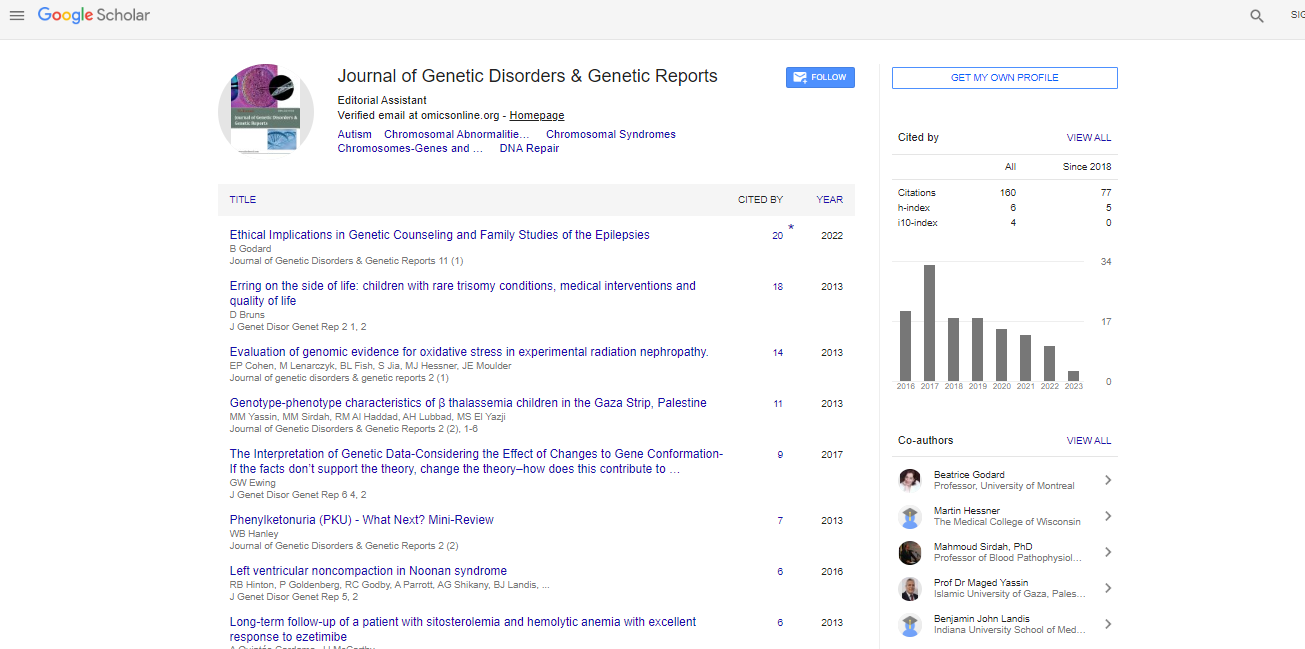Commentary, J Genet Disor Genet Rep Vol: 12 Issue: 5
The Genomic Renaissance: A Comprehensive Overview of Emerging Technologies in Genetic Diagnosis
Sean Adrian*
1Department of Genome Sciences, University of Washington, Seattle, USA
*Corresponding Author: Sean Adrian,
Department of Genome Sciences,
University of Washington, Seattle, USA
E-mail: adriansean43@uni.uow.edu
Received date: 25 September, 2023, Manuscript No. JGDGR-23-120552;
Editor assigned date: 28 September, 2023, PreQC No. JGDGR-23-120552 (PQ);
Reviewed date: 12 October, 2023, QC No. JGDGR-23-12052;
Revised date: 19 October, 2023, Manuscript No. JGDGR-23-120552 (R);
Published date: 26 October, 2023, DOI: 10.4172/2576-1439.1000228.
Citation: Adrian S (2023) The Genomic Renaissance: A Comprehensive Overview of Emerging Technologies in Genetic Diagnosis. J Genet Disor Genet Rep 12:5.
Description
Genetic diagnosis has witnessed remarkable advancements with the advent of cutting-edge technologies. Through an exploration of the strengths, challenges, and applications of these technologies, this article aims to offer a comprehensive overview of the evolving landscape in genetic diagnostics. The landscape of genetic diagnosis has undergone revolutionary changes with the introduction of novel technologies. Single-cell sequencing techniques allow the analysis of individual cells, providing insights into cellular heterogeneity. This technology is particularly valuable for understanding the genetic basis of complex diseases and unraveling the diversity of cell populations within tissues.
Next-Generation Sequencing (NGS)
Next-generation sequencing has emerged as a cornerstone technology in genetic diagnosis, enabling rapid and cost-effective sequencing of entire genomes or targeted gene panels. This section explores the various NGS platforms, including Illumina and Oxford Nanopore technologies, and discusses their applications in clinical diagnostics, rare disease identification, and cancer genomics. The benefits of increased throughput and reduced costs have made NGS a transformative tool in deciphering complex genetic landscapes.
CRISPR-based methods
The revolutionary CRISPR-Cas9 technology has transcended in its initial role in genome editing to become a powerful tool in genetic diagnosis. This section discusses the applications of CRISPR-based methods, such as CRISPR-Cas12 and CRISPR-Cas13, in detecting specific genetic sequences associated with diseases. The precision and versatility of CRISPR technologies offer diagnostic capabilities, enabling targeted identification of genetic mutations and variations.
Liquid biopsy
Liquid biopsy has emerged as a non-invasive and promising approach for genetic diagnosis, particularly in cancer. This section explores the use of circulating tumor DNA (ctDNA) and other biomarkers in blood, urine, and other bodily fluids for detecting genetic alterations. Liquid biopsy's potential for early cancer detection, monitoring treatment response, and identifying minimal residual disease marks a paradigm shift in genetic diagnostics.
Single-cell genomics
Advancements in single-cell genomics have provided unprecedented resolution in understanding genetic heterogeneity within tissues and organisms. This section explores the applications of single-cell technologies, such as single-cell RNA sequencing and single-cell DNA sequencing, in unraveling the complexities of genetic disorders. The ability to study individual cells enhances our understanding of disease mechanisms, paving the way for more precise diagnostics and targeted therapies. Advances in functional genomics, including technologies like CRISPR screening and RNA interference, enable the systematic study of gene function. This contributes to a deeper understanding of how genetic variations impact cellular processes and provides insights into disease mechanisms.
Challenges and ethical considerations
Despite the transformative potential of emerging technologies, challenges such as data management, standardization, and ethical considerations persist. This section discusses the importance of addressing these challenges to ensure the responsible and equitable integration of emerging technologies into routine clinical practice. Ethical considerations related to patient consent, data privacy, and the potential misuses of genetic information are major aspects that require ongoing attention. This section provides insights into the current and potential clinical applications of emerging genetic diagnostic technologies. From rare diseases to oncology, the transformative impact of these technologies on patient care is discussed.
Conclusion
Emerging technologies have revolutionized the field of genetic diagnosis, offering unprecedented insights into the genetic basis of diseases. From next-generation sequencing to CRISPR-based methods, liquid biopsy, and single-cell genomics, these technologies are reshaping how we understand, diagnose, and treat genetic disorders. This comprehensive review underscores the transformative potential of emerging genetic diagnostic technologies and their profound implications for the future of personalized medicine.




